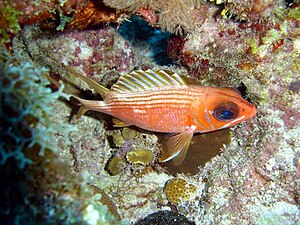Long-spiked hussar
| Long-spiked hussar | ||||||||||||
|---|---|---|---|---|---|---|---|---|---|---|---|---|

Long-spiked hussar ( Holocentrus rufus ) |
||||||||||||
| Systematics | ||||||||||||
|
||||||||||||
| Scientific name | ||||||||||||
| Holocentrus rufus | ||||||||||||
| ( Walbaum , 1792) |
The long-spiked hussar ( Holocentrus rufus ), also known as the Caribbean squirrel fish, is a fish from the family of soldier and hussar fish and is assigned to the subfamily of hussar fish . It lives in the tropical west Atlantic from southern Florida via Bermuda , the northwestern Gulf of Mexico and the Antilles to the north coast of South America . It occurs up to a depth of 35 meters.
features
The basic color of this 30 to 35 centimeter large fish is red with light vertical stripes. Occasionally, light spots on the body can also be seen. Behind the tip of each fin spine of the white, hard-rayed part of the dorsal fin sits a white, triangular spot. The yellow soft-rayed part of the dorsal fin is drawn out long in front. The rear edge of the jaw extends behind the middle of the eye.
Like other hussar fish, the long-spiked hussar can make sounds. To do this, muscles are contracted and the swim bladder acts as an acoustic amplifier. These sounds can be heard when there is danger and when the fish is defending itself.
- Fin formula : dorsal XI / 14-16, anal IV / 9-11.
Way of life
The long-spiked hussar lives in coral and rock reefs. The mostly nocturnal species lives individually and is mainly found at cave entrances, at night it goes hunting over sandy areas and sea grass meadows. It feeds mainly on crustaceans, molluscs, brittle stars and small fish.
literature
- Hans A. Baensch / Robert A. Patzner: Mergus Sea Water Atlas Volume 7 Perciformes (perch-like) , Mergus-Verlag, Melle, 1998, ISBN 3-88244-107-0
Web links
- Langstachelhusar on Fishbase.org (English)